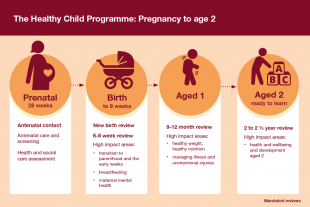 Today, we’ve published findings from work looking to create child development outcomes indicators in our new report. We’ve been looking at how data health visitors collect from their use of the ASQ-3 during the development review might be used to create indicators at a national level as part of the Public Health Outcomes Framework. For those of you who are involved in the collection or submission of data you may wonder what happens to it, so I hope you find this blog and report helpful in understanding the way it gets used and benefits it provides in developing improved services for children.
Today, we’ve published findings from work looking to create child development outcomes indicators in our new report. We’ve been looking at how data health visitors collect from their use of the ASQ-3 during the development review might be used to create indicators at a national level as part of the Public Health Outcomes Framework. For those of you who are involved in the collection or submission of data you may wonder what happens to it, so I hope you find this blog and report helpful in understanding the way it gets used and benefits it provides in developing improved services for children.
This offers real opportunities for local areas to compare how children are developing with what’s happening elsewhere, both in their region and with similar populations in other parts of England – it’s a really good way to look at the impact of local early years services and how yours compares to others. The data will also allow us to examine how the way in which children develop might be different in different social groups. Understanding these differences helps us target our work towards those with the greatest need.
As part of the Healthy Child Programme development review, many of you will have been using the Ages and Stages Questionnaire (ASQ-3) in the review all children are offered by health visitors between the ages of 2 and 2 ½ years. While not a screening tool, it does provide an objective measure of development, allowing comparisons which help to identify children who are not developing as expected and supporting decisions on closer monitoring of progress or the targeting of services. Using the tool lets us test every child’s development at this critical point, including looking at communication, physical skills, problem-solving and how a child is developing emotionally and socially.

The study published today worked with data collected in three local services during development reviews using the ASQ-3 to investigate how such information might be used nationally to create useful indicators for local areas. Analysing this data found that just over 89% of children in these three areas were at or above the expected level of development in all five development domains of the ASQ-3.
Results for individual development domains differed slightly as did the scores between boys and girls. In terms of inequalities, we found that children living in the most deprived areas have a lower chance of achieving the overall expected level of development than those living in the least deprived areas.
While these findings are interesting, they only reflect what’s happening in these three areas. The real benefit will come if we can analyse data for all local areas in the same way. Only by doing this will we understand both what the picture is for child development across England and how what’s happening in each area compares with others. Encouragingly the study shows that it should be possible to generate such indicators at a local level in a meaningful way each year. Adopting this method is also efficient as the data is already collected in development reviews and collated by NHS Digital as part of the Community Services Data Set.
The findings are, however, consistent with those from other cohort studies which look at associations between deprivation and child development such as the Millennium Cohort Study and The Language Epidemic. Such studies provide important evidence but there is significant benefit in additional indicators based on data from the ASQ-3 collected into the Community Services Data Set as it covers all of England. This means that we can produce information about local areas and how they compare. It also gives a longitudinal view of children and offers the potential to increase our understanding and evidence-base for the relationship between outcomes in early and later life.
But to do this, we must have good data. The feasibility study has shown that we can develop indicators in the future which inform the way we plan services. Making sure that information from the ASQ-3 is always fully recorded electronically locally not only benefits the child in front of us but ensures that we can gain an overview of the child population generally. From this, meaningful indicators can be developed which increase our ability to target health visiting services towards those children who are likely to benefit the most, ensuring that all children develop key skills at this early age which shape their future lives.
Viv Bennett is Chief Nurse and Director of Maternity and Early Years at Public Health England
